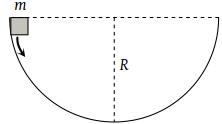A particle of mass 10 kg is moving with velocity of m/s, where x is displacement . The work done by net force during the displacement of particle from x = 4 to x = 9 m is
1. 1250 J
2. 1000 J
3. 3500 J
4. 2500 J
The relation between velocity (v) and time (t) is , then which one of the following quantity is constant?
1. Force
2. Power
3. Momentum
4. Kinetic Energy
A particle is moving on the circular path of the radius (R) with centripetal acceleration . Then the correct relation showing power (P) delivered by net force versus time (t) is

1. 1
2. 2
3. 3
4. 4
A body is displaced from (0,0) to (1m,1m) along the path x=y by a force . The work done by this force will be :
1.
2.
3.
4.
A weightless rod of length 2l carries two equal mass 'm', one tied at lower end A and the other at the middle of the rod at B. The rod can rotate in a vertical plane about a fixed horizontal axis passing through C. The rod is released from rest in the horizontal position. The speed of the mass B at the instant rod becomes vertical is:

1. \(\sqrt{\frac{3 g l}{5}} \)
2. \(\sqrt{\frac{4 g l}{5}} \)
3. \(\sqrt{\frac{6 g l}{5}} \)
4. \(\sqrt{\frac{7 g l}{5}} \)
A force F is applied on a body which moves with a velocity v in the direction of the force, then the power will be
1.
2. Fv
3.
4. F/v
Potential energy \((U)\) related to coordinates is given by; \(U=3(x+y).\) Work done by the conservative force when the particle is going from \((0,0), (2,3)\) is:
1. \(15\) J
2. \(-15\) J
3. \(12\) J
4. \(10\) J
A mass m slips along the wall of a semispherical surface of radius R. The velocity at the bottom of the surface is [ MP PMT 1993]

1.
2.
3.
4.
Three different objects of mass and m3 are allowed to fall from rest and from the same point ‘O’ along three different frictionless paths. The speeds of the three objects, on reaching the ground, will be in the ratio of:
| 1. | 2. | ||
| 3. | 1 : 1 : 1 | 4. |







